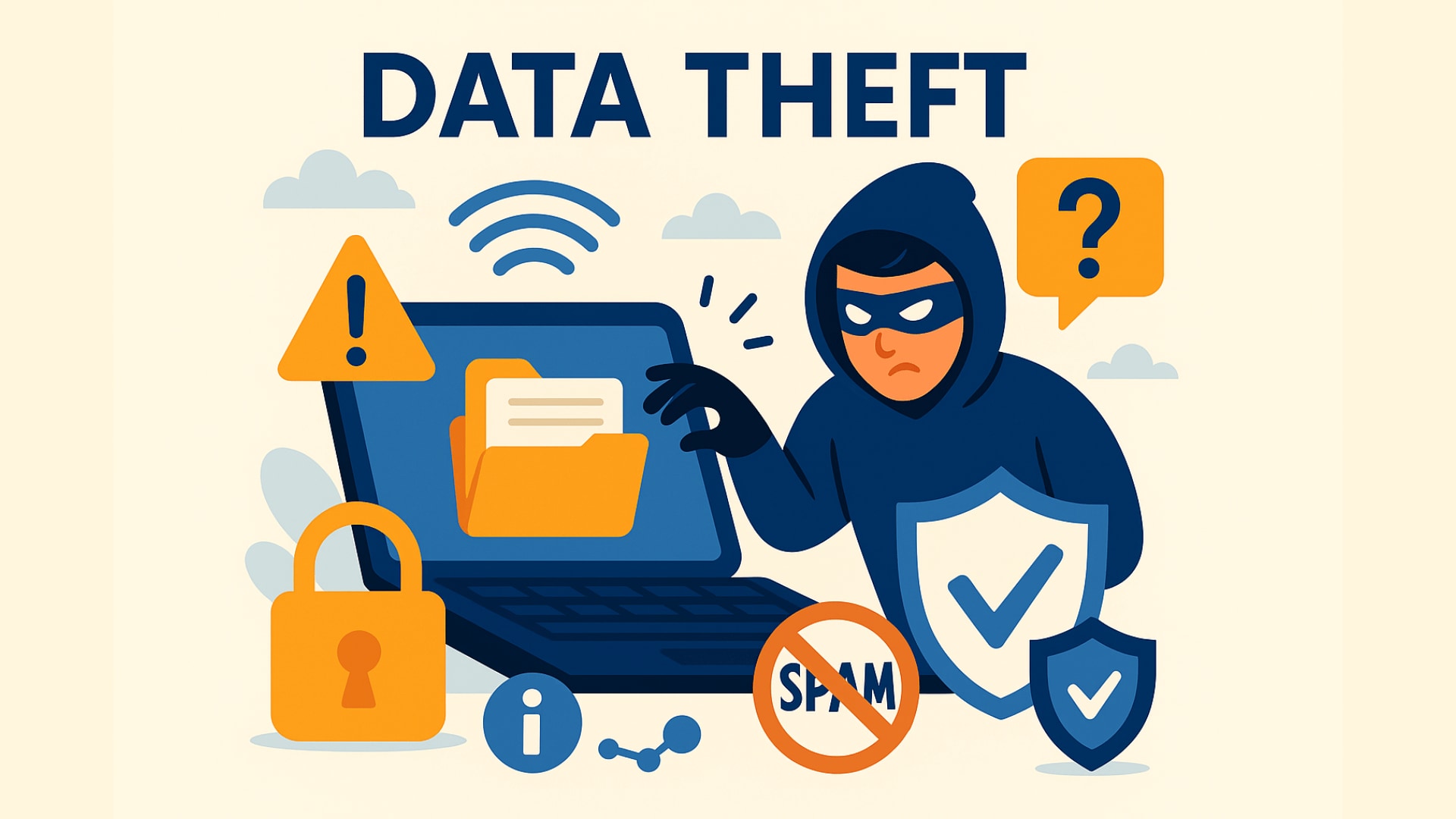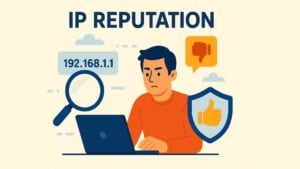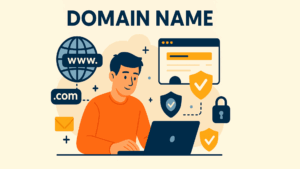
Data is more than just information — it’s an asset. It powers marketing campaigns, secures customer relationships, fuels decision-making and represents trust between users and businesses. But just as data has become more valuable, so have the threats to its security. Among the most serious of these threats is data theft.
Unlike traditional theft, where something tangible is physically removed, data theft involves the unauthorized copying or transfer of digital information. The original files often remain in place, making the intrusion invisible at first glance. This kind of attack can go unnoticed for weeks or even months, while stolen data is quietly misused, sold, or held for ransom.
Understanding what data theft is and how it happens is a vital part of building a resilient cybersecurity strategy. Whether you’re managing a website, leading IT infrastructure, or simply trying to protect sensitive information, gaining clarity on this topic can help you mitigate risks and respond effectively when threats emerge.
Table of contents
Understanding Data Theft
Data theft refers to the unauthorized acquisition of sensitive information, usually with malicious intent. While often confused with a data breach or data leak, these terms have distinct meanings. A breach typically implies forced access into a secured system, while a leak is usually accidental, such as when data is left unsecured and becomes publicly accessible. Data theft, in contrast, focuses on the illicit act of copying and stealing data — regardless of whether that access was gained legally or illegally.
This act can affect any organization that handles digital records, whether it’s financial data, login credentials, or proprietary business information. It’s not limited to large corporations — small businesses are frequently targeted due to often weaker security postures.
Why Data Is Stolen
The motives behind data theft are largely financial. Cybercriminals often steal data to sell it on black markets, commit fraud, or gain unauthorized access to financial accounts. Stolen identities can be used to apply for credit, conduct social engineering attacks or impersonate someone to access sensitive systems.
In other scenarios, attackers might aim to disrupt operations or gain a competitive edge. For example, stealing intellectual property or internal communications could offer strategic advantages in highly competitive industries.
How Data Theft Happens
Data theft can occur through a blend of technical exploits and human vulnerabilities. A typical attack might start with a phishing email disguised as a message from a trusted source — like a bank or internal IT department. When an employee clicks the malicious link and enters their credentials, attackers gain entry into internal systems. From there, they might install malware that silently scans for sensitive files or opens backdoors for continuous access.
Weak passwords and reused credentials are another common vulnerability. Many attackers use credential stuffing techniques, where previously leaked login information is used to access multiple accounts. Once inside, they can escalate privileges or move laterally within a network to exfiltrate valuable data.
Outdated systems and misconfigured cloud services provide other points of entry. Hackers often scan for unpatched vulnerabilities to exploit, allowing them to bypass authentication or gain administrative control. Insider threats — employees or contractors with access — can also intentionally steal or leak data.
Even seemingly low-tech methods, like physically stealing a laptop or intercepting information on unsecured public Wi-Fi, can lead to data theft. Shoulder surfing — where someone watches you input sensitive information in a public place — can also compromise credentials. In many cases, multiple methods are combined, making these attacks both sophisticated and hard to detect.
What Kind of Data Is at Risk?
Virtually all types of digital information can be targeted. Personally identifiable information (PII), such as names, addresses and social security numbers, is especially valuable for identity theft. Financial data — like bank account numbers and credit card details—can be exploited for fraudulent transactions.
Organizations are also vulnerable to the theft of business-critical assets, including employee records, client databases, proprietary algorithms and confidential communications. Medical information is another high-risk category, often targeted for insurance fraud or extortion.
The Consequences of Data Theft
For businesses, the cost of data theft goes beyond immediate financial loss. Investigations, system restorations and legal actions can be expensive. Regulatory fines for non-compliance with data protection laws like GDPR add another layer of risk.
The reputational damage can be even harder to recover from. Customers who lose trust in a company’s ability to protect their data may take their business elsewhere. In worst-case scenarios, operational downtime and stolen intellectual property can threaten a company’s long-term viability.
Individuals affected by data theft may experience identity theft, unauthorized financial activity, and long-term privacy violations. Recovery can be time-consuming and emotionally distressing, especially when personal or professional relationships are impacted.
How to Prevent Data Theft
Defending against data theft requires a proactive and layered approach. Strong, unique passwords are foundational — ideally stored in a secure password manager. Enabling multi-factor authentication (MFA) adds an additional barrier to unauthorized access.
Keeping systems and software up to date is essential for closing known vulnerabilities. Employee training also plays a critical role. When users understand how to spot phishing attempts or suspicious downloads, they become active participants in security.
Access control should be managed carefully. Employees should only access the data they need and permissions should be reviewed regularly. Secure backups and encrypted storage provide safety nets in case an attack is successful.
Monitoring tools and cybersecurity software can alert organizations to unusual activity in real time, while secure network practices—like using a VPN or avoiding untrusted public Wi-Fi — add another layer of protection.
Data Theft and Web Security
With websites acting as digital storefronts and service hubs, protecting them is a critical part of any data protection strategy. Attackers increasingly use automated tools to exploit vulnerabilities in forms, user logins, or APIs to extract data. Web-based threats like scraping, credential stuffing, or brute-force login attempts can open the door to larger-scale data theft.
This is where security measures like CAPTCHA systems become vital. They help block automated attacks by verifying that interactions are coming from humans, not bots. These protections serve as the first line of defense at the application layer — the very layer where users enter sensitive information.
Solutions like those offered by captcha.eu combine privacy-first technology with accessibility standards, allowing businesses to differentiate between real users and automated scripts without compromising user experience. By preventing fake registrations, spam and automated credential abuse, CAPTCHA tools reduce one of the most common vectors for data theft and support a secure web experience.
Conclusion
Data theft remains one of the most pressing digital threats facing businesses today. From financial damage and legal consequences to a loss of customer trust, the fallout from a single incident can be severe and long-lasting. But with a proactive, well-informed approach — combining technical safeguards, user education and strong policies — organizations can dramatically reduce their risk.
As cyberattacks become more sophisticated, so must our defenses. That includes securing websites and online services against automated threats like bots, which are often the first step in larger data theft campaigns. Solutions — like those from captcha.eu — provide a privacy-first, accessible way to verify real users and stop malicious automation before it can cause harm.
Safeguarding your data isn’t just an IT task — it’s a business imperative. Start building a more secure future today.
FAQ – Frequently Asked Questions
What is data theft in simple terms?
Data theft is the unauthorized copying or transfer of digital information, typically for malicious purposes. Unlike physical theft, the original data often remains in place, making the theft harder to detect.
How is data theft different from a data breach or data leak?
A data breach usually involves unauthorized access to systems, while a data leak often results from accidental exposure. Data theft specifically refers to the intentional and illegal acquisition or copying of data.
What types of data are most commonly targeted?
Common targets include personally identifiable information (PII), financial records, login credentials, intellectual property, medical data, and confidential business documents.
Who is most at risk of data theft?
Any individual or organization that stores or processes digital data can be at risk. Small and medium-sized businesses are often targeted due to less robust security systems.
How do CAPTCHA systems help prevent data theft?
CAPTCHAs protect websites from automated bots that might try to steal data via fake sign-ups, brute-force logins, or scraping. They act as a gatekeeper at the application layer.
100 free requests
You have the opportunity to test and try our product with 100 free requests.
If you have any questions
Contact us
Our support team is available to assist you.




